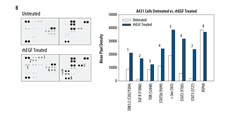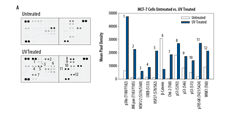Proteome Profiler Human Phospho-Immunoreceptor Array Kit
Proteome Profiler Human Phospho-Immunoreceptor Array Kit Summary
Kit Summary
A membrane-based antibody array for the parallel determination of the relative phosphorylation of human immunoreceptors. Validated for analyte detection in cell lysates.
Key Benefits
- Detects phosphorylation of 59 human ITAM/ITIM-associated immunoreceptors simultaneously
- Requires no specialized equipment
Principle of the Assay
The Proteome Profiler Human Phospho-Immunoreceptor Array Kit is a membrane-based sandwich immunoassay. Capture antibodies spotted in duplicate on nitrocellulose membranes bind to specific target proteins present in the sample (Step 1). Tyrosine phosphorylation of the captured proteins is detected with an HRP-conjugated pan phospho-tyrosine antibody (Step 2) and then visualized using chemiluminescent detection reagents (Step 3). The signal produced is proportional to the amount phosphorylation in the bound analyte.
Why Use an Antibody Array to Detect Receptor Phosphorylation?
Determining the phosphorylation of multiple immunoreceptors in a single sample can be expensive, time consuming and can require specialized equipment. Performing multiple immunoprecipitations and Western blots requires time, labor, and reagents. The use of a multiplex antibody array to detect multiple phosphorylations in a single sample can be cost-effective and also save time and sample.
Kit Contents
This kit contains the following azide-free, fluorochrome-conjugated antibodies to verify human stem cell pluripotency:
- 4 Array Membranes
- 4-Well Multi-dish
- Array Buffers
- Lysis Buffer
- Wash Buffer
- HRP-conjugated Anti-phospho-tyrosine Detection Antibody
- Chemiluminescent Detection Reagents
- Transparency Overlay Template
- Detailed Protocol
For a complete list of the kit contents and necessary materials, please see the Materials Provided/Other Supplies Required sections of the product datasheet.
| Simultaneously detect the relative phosphorylation levels of these immunoreceptors in a single sample. | ||
| 2B4/SLAMF4 | FcRH1/IRTA5 | NKp46/NCR1 |
| BLAME/SLAMF8 | FcRH2/IRTA4 | NKp80/KLRF1 |
| BTLA | FcRH4/IRTA1 | NTB-A/SLAMF6 |
| CD3 epsilon | FcRH5/IRTA2 | PD-1 |
| CD5 | ILT2/CD85j | PECAM/CD31) |
| CD6 | ILT3/CD85k | SHIP-1 |
| CD28 | ILT4/CD85d | SHP-1 |
| CD84/SLAMF5 | ILT5/CD85a | SHP-2 |
| CD229/SLAMF3 | ILT6/CD85e | Siglec-2/CD22 |
| CEACAM-1 | Integrin beta 3/CD61 | Siglec-3/CD33 |
| CLEC-1 | KIR2DL4 | Siglec-5 |
| CLEC-2 | LAIR-1 | Siglec-7 |
| CRACC/SLAMF7 | LAIR-2 | Siglec-9 |
| CTLA-4/CD152 | LMIR1/CD300A | Siglec-10 |
| DCIR/CLEC4A | LMIR2/CD300C | SIRP-beta 1 |
| Dectin-1/CLEC7A | LMIR3/CD300LF | SLAM/CD150 |
| DNAM-1 | LMIR6/CD300LE | TREM-1 |
| Fc epsilon RII/CD23 | MDL-1/CLEC5A | TREM-2 |
| Fc gamma RIIA | NKp30/NCR3 | TREML1/TLT-1 |
| Fc gamma RIIIA/B | NKp44/NCR2 | |
Specifications
Product Datasheets
Scientific Data
 View Larger
View Larger
The Human Phospho-Immunoreceptor Array detects multiple tyrosine phosphorylated immunoreceptors in lysates prepared from cells activated by antibody mediated cross-linking of cell-surface immunoreceptors. Jurkat human acute T cell leukemia cells were incubated with a mouse monoclonal anti-CD3 epsilon antibody (R&D Systems, Catalog # MAB100) or mouse IgG1 isotype control (R&D Systems, Catalog # MAB002) followed by incubation with a goat anti-mouse antibody (R&D Systems, Catalog # AF007) for 5 minutes. 100 µg of lysate was run on each array.
 View Larger
View Larger
The Human Phospho-Immunoreceptor Array detects multiple tyrosine phosphorylated immunoreceptors in lysates prepared from cells activated by antibody mediated cross-linking of cell-surface immunoreceptors. THP-1 human acute monocytic leukemia cells were incubated with goat anti-Fc gamma RIIA antibody (R&D Systems, Catalog # AF1875) or normal goat IgG (R&D Systems, Catalog # AB-108-C) followed by incubation with a donkey anti-goat IgG antibody (R&D Systems, Catalog # AF109) for 5 minutes [Maresco, D.L. et al. (1999) J. Immunol. 162:6458].
Citations for Proteome Profiler Human Phospho-Immunoreceptor Array Kit
R&D Systems personnel manually curate a database that contains references using R&D Systems products. The data collected includes not only links to publications in PubMed, but also provides information about sample types, species, and experimental conditions.
9
Citations: Showing 1 - 9
Filter your results:
Filter by:
-
Natural Killer Cell Dysfunction In Human Bladder Cancer Is Caused By Tissue-Specific Suppression of SLAMF6 Signaling
Authors: Farkas, AM;Tran, MA;Youssef, D;Balan, S;Newman, JH;Audenet, F;Anastos, H;Peros, A;Ananthanarayanan, A;Daza, J;Gonzalez-Gugel, E;Sadanala, K;Theorell, J;Galsky, MD;Horowitz, A;Sfakianos, JP;Bhardwaj, N;
bioRxiv : the preprint server for biology 2024-05-03
-
HuM195 and its single-chain variable fragment increase A? phagocytosis in microglia via elimination of CD33 inhibitory signaling
Authors: Wong, E;Malviya, M;Jain, T;Liao, GP;Kehs, Z;Chang, JC;Studer, L;Scheinberg, DA;Li, YM;
Molecular psychiatry 2024-02-21
-
A LILRB1 variant with a decreased ability to phosphorylate SHP-1 leads to autoimmune diseases
Authors: T Sinthuwiwa, S Buranaprad, W Kamolvisit, S Tongkobpet, W Chetruengc, C Srichomtho, A Assawapita, C Phokaew, P Kueanjinda, T Palaga, T Boonpiyath, K Suphapeeti, N Hirankarn, V Shotelersu
Scientific Reports, 2022-09-14;12(1):15420. 2022-09-14
-
CD276 is an important player in macrophage recruitment into the tumor and an upstream regulator for PAI-1
Authors: S Durlanik, K Fundel-Cle, C Viollet, HJ Huber, M Lenter, K Kitt, S Pflanz
Scientific Reports, 2021-07-21;11(1):14849. 2021-07-21
-
Low RECK Expression Is Part of the Cervical Carcinogenesis Mechanisms
Authors: S Herbster, M Trombetta-, PT de Souza-S, A Paladino, CRF Silveira, MC Sogayar, LL Villa, AP Lepique, E Boccardo
Cancers, 2021-05-06;13(9):. 2021-05-06
-
Molecular basis of reduced LAIR1 expression in childhood severe malarial anaemia: Implications for leukocyte inhibitory signalling
Authors: AO Achieng, B Guyah, Q Cheng, JM Ong'echa, C Ouma, CG Lambert, DJ Perkins
EBioMedicine, 2019-06-27;45(0):278-289. 2019-06-27
-
Evidence for C1q-mediated crosslinking of CD33/LAIR-1 inhibitory immunoreceptors and biological control of CD33/LAIR-1 expression
Authors: M Son, B Diamond, BT Volpe, CB Aranow, MC Mackay, F Santiago-S
Sci Rep, 2017-03-21;7(1):270. 2017-03-21
-
Fibroblast Growth Factor Receptor 3 (FGFR3) Associated with the CD20 Antigen Regulates the Rituximab-induced Proliferation Inhibition in B-cell Lymphoma Cells.
Authors: Kotani N, Ishiura Y, Yamashita R, Ohnishi T, Honke K
J Biol Chem, 2012-08-29;287(44):37109-18. 2012-08-29
-
Surface molecule CD229 as a novel target for the diagnosis and treatment of multiple myeloma.
Authors: Atanackovic D, Panse J, Hildebrandt Y, Jadczak A, Kobold S, Cao Y, Templin J, Meyer S, Reinhard H, Bartels K, Lajmi N, Zander AR, Marx AH, Luetkens T, Bokemeyer C, Kroger N
Haematologica, 2011-05-23;0(0):. 2011-05-23
FAQs
-
The insert states to lyse 1 x 107 cells in 1 mL Lysis Buffer 17. What is the approximate protein concentration of the resulting lysate?
Lysing following recommendations in the product insert produces a lysate with a protein concentration of about 1.5-2.0 mg/mL. Quantitation of sample protein concentration using a total protein assay is recommended.
Reviews for Proteome Profiler Human Phospho-Immunoreceptor Array Kit
Average Rating: 5 (Based on 1 Review)
Have you used Proteome Profiler Human Phospho-Immunoreceptor Array Kit?
Submit a review and receive an Amazon gift card.
$25/€18/£15/$25CAN/¥75 Yuan/¥2500 Yen for a review with an image
$10/€7/£6/$10 CAD/¥70 Yuan/¥1110 Yen for a review without an image
Filter by:














